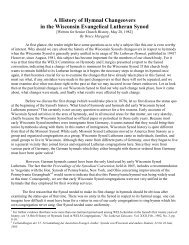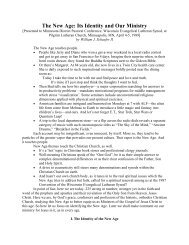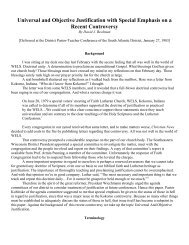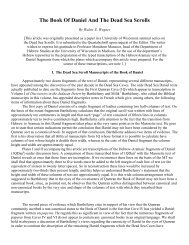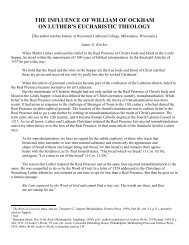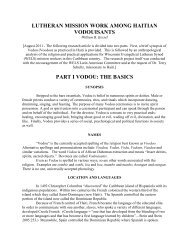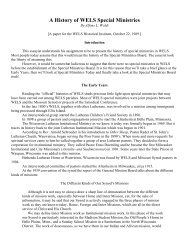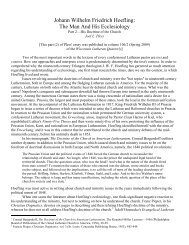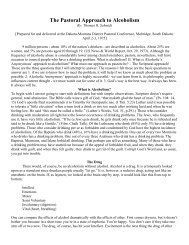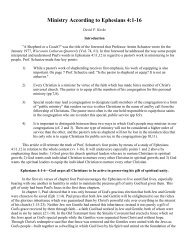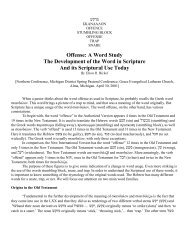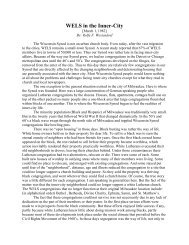Strangers to Sisters - Wisconsin Lutheran Seminary Library: Essays
Strangers to Sisters - Wisconsin Lutheran Seminary Library: Essays
Strangers to Sisters - Wisconsin Lutheran Seminary Library: Essays
Create successful ePaper yourself
Turn your PDF publications into a flip-book with our unique Google optimized e-Paper software.
church union. It also shows that the various defenses made by both synods individually<br />
were not carried out in a vacuum, but were discussed as full brothers. In short, this<br />
correspondence shows a real fraternal bond between the ELS and the WELS. The WELS<br />
was not <strong>to</strong>o big <strong>to</strong> consult her smaller sister when they were seeking <strong>to</strong> formulate their<br />
reply <strong>to</strong> the ULCA. The ELS was not <strong>to</strong>o small <strong>to</strong> speak up and coordinate their efforts<br />
with the WELS in admonishing the Missouri Synod. This correspondence shows that the<br />
WELS and the ELS were not fighting individual battles with a common adversary, but<br />
were locked arm and arm when they faced that common adversary, supporting and<br />
coordinating their efforts with each other.<br />
II. The ELS defense of the WELS position on Church and Ministry (1940s-1950s)<br />
The hermeneutical shibboleth among American <strong>Lutheran</strong>s is how one speaks<br />
concerning the doctrines of church and ministry. Indeed, much of the dispute that has<br />
occurred over these doctrines is really a result of differing methodology in the<br />
interpretation of Holy Scripture. The more the current intra-ELS dispute over church and<br />
ministry evolves, the clearer it becomes that what is really at issue is the manner in which<br />
either side approaches the Scriptures in the formulation of doctrine. Indeed, the more one<br />
researches the church and ministry debate in the ELS during the 40s and 50s, the more<br />
one gets the feeling of dejavu in the present discussions. 239<br />
239 Part of what clouds the discussion of these doctrines is that older terminology came <strong>to</strong> mean something<br />
different in subsequent generations. The problem therefore is not simply the terminology employed, but<br />
trying <strong>to</strong> divine what exactly was meant by those who employed it. For instance, many in the ELS<br />
employed “Missouri” terminology when discussing church and ministry without endorsing the “Missouri”<br />
position. There is a correlation here between language gaps that orthodox Christians had <strong>to</strong> wrestle with in<br />
the 3 rd and 4 th centuries during Chris<strong>to</strong>logical controversies.<br />
124



